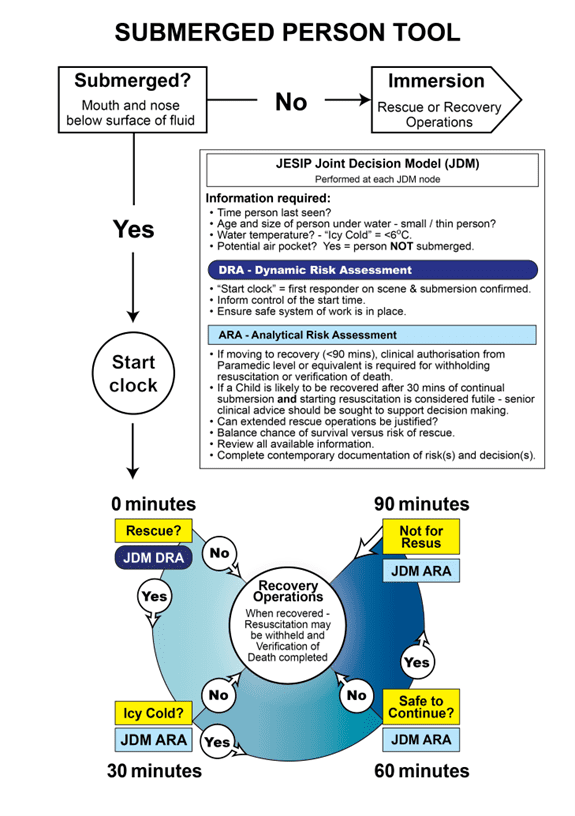Apply the submerged person tool
Control Measure Knowledge

Figure: Submerged person tool (2024 version), courtesy of JESIP
Note: A PDF version of the submerged person tool can be downloaded here
An incident for the rescue of a submerged person will usually require a multi-agency response. For this reason, JESIP have developed the submerged person tool, to support joint decision-making and the development of a multi-agency operational response plan.
If the fire and rescue service is first on-scene, they should request the attendance of other appropriate agencies at the earliest opportunity, including:
- Police
- Ambulance
- Maritime and Coastguard Agency
- Specialist dive teams
- Rescue organisations
The tool is designed to give a submerged person every reasonable chance of rescue and resuscitation and is balanced against the risk of harm to personnel when carrying out rescues. The following content has been provided to assist fire and rescue services in applying the tool, and to support incident commanders who participate in the joint decision-making process.
Information required
If fire control takes a call about a submerged person, they should include asking for:
- Time person last seen
- Age and size of person
- What the person is wearing
It may be possible to gather further information from witnesses at the scene of the incident that could inform decision-making and the application of the tool.
Personnel on-scene may be able to estimate the temperature of the water. For further information refer to Check water and tidal conditions. It may also be possible to determine if the submerged person could be in an air pocket, for example, inside a vehicle or underneath an upturned canoe.
Joint Decision-Making Dynamic Risk Assessment
It is not possible to know for certain when a person became submerged, so the clock should start when the first emergency responder arrives on-scene and submersion has been confirmed. It should not be assumed that the person has been submerged for longer than this.
Incident commanders should notify fire control of the start time and put a safe system of work in place for personnel. This forms the zero-minute Joint Decision-Making Dynamic Risk Assessment (JDMDRA) point of the tool.
Joint Decision-Making Analytical Risk Assessment
The Joint Decision-Making Analytical Risk Assessment (JDMARA) supports the decision-making of all agencies on-scene.
If moving to recovery (<90 minutes), clinical authorisation from paramedic level or equivalent is required for withholding resuscitation or verification of death. This is to provide clinical support, through joint decision-making, to avoid unnecessary risk to emergency responders undertaking prolonged rescue attempts, where the person submerged would not survive.
If a child is likely to be recovered after 30 minutes of continual submersion and starting resuscitation is considered futile, senior clinical advice should be sought to support decision-making. For the purpose of the tool, a child is classified as being up to the age of 18 years old, including infants of up to one year old. Unless the senior clinical advice states otherwise, a recovered child cannot be verified as deceased and has to be resuscitated to hospital.
Can extended rescue operations be justified? The tool allows for this to be reviewed at the 30-, 60- and 90-minute JDMARA points. It is accepted that there may be situations when responders wish to continue rescue operations, if safe to do so, for a short period of time, despite survival of the person not being possible.
An example would be when the family are on-scene, with the person having been located in warm water and 35 minutes having passed since the clock started. In this situation a joint decision could be taken that their recovery occurs for the sake of the family, but that resuscitation attempts would not take place.
Balance chance of survival versus risk of rescue. The tool allows for this to be reviewed at the 30-, 60- and 90-minute JDMARA points.
Review all available information. This could include:
- Age and size of person – the submerged person needs to be at a higher risk of hypothermia and rapid body cooling (and therefore be able to benefit from hypothermic protection). This includes people whose body size is small, thin or childlike. This may mean that the JDMARA disregards them being a child if they have an adultlike body size.
- What clothing and footwear the person is wearing – this may have an impact on their buoyancy and temperature
- Video records of the person becoming submerged, for example from:
- Photos or videos from mobile phones
- Visual awareness systems, such as 999eye
- Closed-circuit television (CCTV) footage
- Drone footage
- Temperature of the water–for prolonged survival times of a submerged person, this needs to be less than 6°C, often described as ‘icy cold’
- If the person could be in an air pocket
Complete contemporary documentation of risks and decisions. A log should be kept of all risk assessments carried out and decisions made.
Recovery operations
The police have responsibility for body recovery and will normally arrange for a deceased person to be removed following an incident. Occasionally the fire and rescue service will be requested to recover a body, when life has been declared extinct or following the required investigation process of the appropriate authority. Personnel should not be put at undue risk to assist with recovery operations.
For more information refer to:
